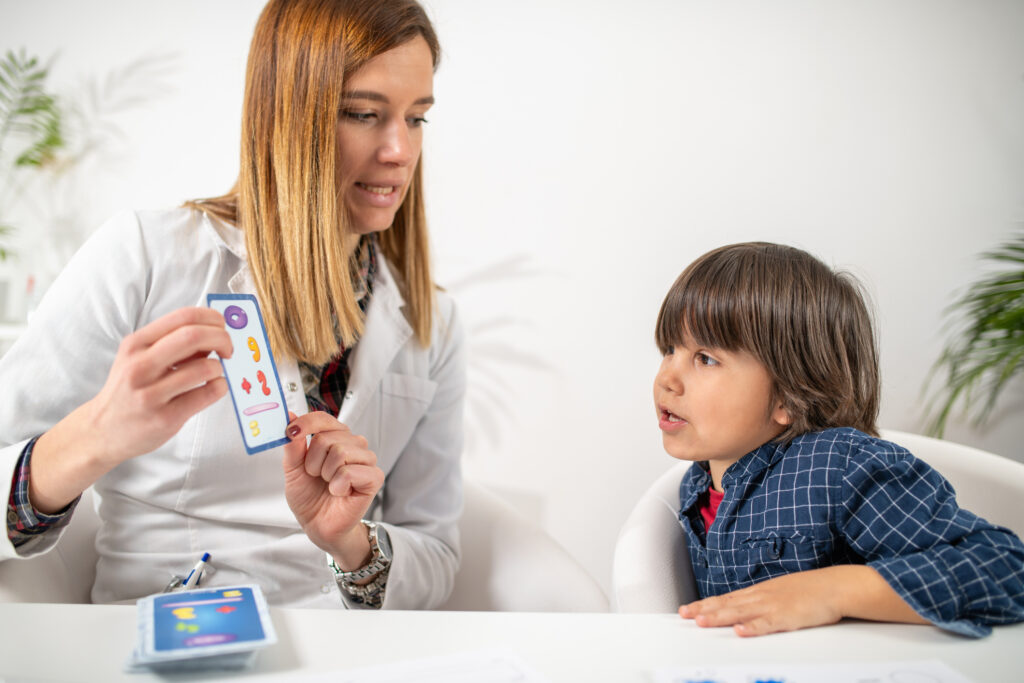Turning a Speech Delay Diagnosis Into Action – Without Overwhelm
Hearing that your child has a speech delay can feel like the beginning of a long, uncertain journey. But with the right steps, support, and tools, you can turn that worry into progress. This guide offers a clear, actionable plan to follow after a speech delay is confirmed – so you can move forward with confidence, not confusion.
Step 1 – Get a Full Professional Evaluation
A confirmed speech delay is only the first piece of the puzzle. The next critical step is to determine whether the delay is isolated or part of a broader developmental pattern. This starts with a team of professionals.
Who You Should See:
- Pediatrician – Your first point of contact. They’ll assess overall health, monitor developmental milestones, and guide referrals.
- Speech-Language Pathologist (SLP) – A licensed therapist who evaluates expressive and receptive language skills. They determine the type and severity of the speech delay and begin crafting a treatment plan.
- Audiologist – Because hearing issues can contribute to speech delays, a hearing evaluation is essential – even if your child seems to hear normally.
- Developmental Pediatrician – If your child has delays in multiple domains (motor, cognitive, social), a specialist in developmental medicine can provide a comprehensive assessment, including for autism or global developmental delay (GDD).
This multidisciplinary approach ensures that nothing important is overlooked and that therapy plans are matched to your child’s specific needs.
Step 2 – Use Screening Tools That Clarify What’s Next
Once professionals are involved, structured screening tools can help map out the journey ahead. These tools quantify your child’s current developmental level, giving a clearer picture of what’s typical, what’s not, and how urgent intervention might be.
Tools That Help:
- ✅ Family Health Checker
This free tool from FDNA gathers detailed insights into your child’s behaviors, communication, and development across multiple domains. It generates a shareable report that aligns with AAP milestone surveillance – and helps your pediatrician quickly identify concerning patterns.
- ✅ LDS / ELMS Tools
The Language Development Survey (LDS) and Expressive Language Milestone Scale (ELMS) are widely used by specialists to measure vocabulary size, sentence structure, and expressive language delays.
These tools give you something more than just a gut feeling – they offer data-backed evidence to guide decisions.
Step 3 – Start Early Intervention Immediately
If your child has a confirmed speech delay, don’t wait to begin therapy.
Between ages 3 to 5, the brain is in a critical neuroplastic phase – meaning it can adapt and learn rapidly. Early support during this window can lead to significant improvements in communication and overall development.
What Early Intervention Looks Like:
- Speech Therapy – Sessions may be one-on-one or in small groups, focused on helping your child improve articulation, vocabulary, language comprehension, and communication strategies.
- Play-Based Learning – For young children, therapy often looks like structured play. It’s engaging and designed to teach through natural interaction.
- Home Practice – Parents are part of the process. SLPs will often give you simple strategies and exercises to reinforce learning at home.
If your child is under 3, ask your pediatrician about state-funded Early Intervention programs – these often provide in-home services at low or no cost.
Step 4 – Consider Genetic Testing (If recommended)
If speech delay is accompanied by other developmental concerns – like motor delays, social difficulty, or unusual physical features – your doctor may recommend genetic evaluation.
According to the American Academy of Pediatrics (AAP), children with persistent Global Developmental Delay (GDD) or suspected intellectual disability should undergo:
- ✅ Chromosomal microarray testing
- ✅ Whole exome sequencing, depending on findings
These tests look for genetic syndromes such as Fragile X, 22q11.2 deletion syndrome, or Down syndrome, which are commonly linked to speech delays.
Why This Matters:
Early genetic testing can clarify the why behind your child’s delay. It often shortens the diagnostic journey, points toward more targeted therapy, and helps avoid unnecessary testing or treatments.
Learn more from the AAP’s guidelines on Genetic Testing for Developmental Delays.
Step 5 – Keep Advocating and Stay Informed
A diagnosis is not a one-time event – it’s the beginning of an evolving process. Your child’s needs will change, and so will the support they require. Staying proactive is key.
Your Advocacy Toolkit:
- 📄 Update the Family Health Checker Report Every 3–6 Months
As your child grows and therapy progresses, their development will shift. Keep the report current and share it with all providers – SLPs, pediatricians, and developmental specialists – to ensure everyone’s aligned.
- 🗂️ Track Progress Across Domains
Don’t just monitor speech. Watch for changes in motor skills, play behavior, learning, and emotional regulation. These areas can offer clues about broader needs or hidden strengths.
- 🧠 Educate Yourself
Stay connected to reputable resources like CDC milestones, AAP recommendations, and FDNA’s Health Resource Center. Knowledge empowers your voice.
📦 Family Health Checker Next‑Steps Toolkit
Call-Out: Update & Share Your Report
Family Health Checker keeps your entire care team in sync, tracking progress and actions in one structured, up-to-date report—so your child’s journey is never disconnected or delayed.
👉 Start or Update Your Report Today – It’s Free
All outputs are non-diagnostic and must be validated through clinical evaluation and appropriate testing.
Final Thoughts
A confirmed speech delay is not the end of the road – it’s the beginning of a new path. With structured steps, supportive tools, and strong advocacy, your child can grow, connect, and thrive.
You don’t have to do it alone. And with trusted guidance from professionals and tools like FDNA’s Family Health Checker, you’ll always know what to do next.



